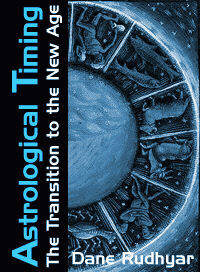 |
| Home | Bio | Art | Music | Literature | Civilization & Culture | Philosophy of Wholeness | Theosophy & Spirituality | Astrology |

ASTROLOGICAL TIMING
The Transition to the New Age by Dane Rudhyar, 1969 First published under the title Birth Patterns for a New Humanity
CONTENTS
PROLOGUE Where Do We Stand Today? PART ONE 1. Three Centuries of Crisis 2. Planetary Cycles 3. Cycles of Relationship PART TWO 4. Stars, Constellations and Signs of the Zodiac 5. From Buddha to Christ 6. The Structure of the Piscean Age 7. At the Gates of the New Age 8. The Aquarius-Leo Age PART THREE 9. The Zodiacal Earth-Field 10. As We Face the Future Page 1 Page 2 Page 3 The March of Civilization Page 4 Wave or Waves? Page 5 The Oceanic Age Page 6 Page 7 EPILOGUE |

CHAPTER TEN
As We Face the Future - 1 Astrology is full of unsolved and perhaps insoluble problems, if it is considered to be anything but a symbolic language — a kind of algebra — enabling us to project patterns of order, derived from the cycles of motion of celestial bodies upon the confusing sequence of existential events on the Earth's biosphere, and especially in our human lives. It is for this reason that entirely different astrological systems can all work well in the hands of astrologers who are familiar with them and who apply them consistently and wisely. In some cases it can be assumed that they work at different levels; for instance, some astrologers have tried to prove that both the sidereal zodiac of constellations and the tropical zodiac of signs are valid, each referring to a certain aspect of life — but there is very little agreement in defining these levels. In discussing the two zodiacs in a previous chapter I stated that the problem concerning the zodiac of constellations was that no one could say why there was such a thing as a constellation — some constellations grouping stars of different types, ages, and moving in different directions -and, in any case, where the precise boundaries of these constellations were located. Even if we accept the claims of present-day advocates of a sidereal zodiac, claims based on what the Chaldean or Egyptian astrologers apparently used as a basis for their charts, this really need not warrant the confusion brought to modern astrological practice by the use of the archaic frame of reference. Why should we accept Chaldean or Egyptian astrology any more than we accept the mythological stories of these long extinct cultures as foundations for our religious approach to the universe? What I am saying here is that every great culture has its own set of symbols which express what is too deep and too vital to be formulated in rigidly intellectual and analytical or measurable terms. Even what we call modern science has its own basic postulates, its special type of logic, its own way of looking at existence; and this way has undergone a very profound transformation around the beginning of this century. There is no reason why we should not build a new kind of astrology; no reason why a new type of celestial frame of reference (a new zodiac) was not necessary after the great change in the deep mind of humanity during and after the sixth century BC which was also about the time when astrology began really to spread in the Hellenistic civilization via the Greek colonies in Asia Minor. The tropical zodiac of signs also poses a basic problem which can probably be solved only in one of two ways; and neither of them is acceptable to everyone. That problem is the result of the fact that the seasons experienced in the moderate zones of the northern hemisphere are reversed in the southern hemisphere. When the Sun is in the sign, Aries, it is springtime in the northern hemisphere, but fall time south of the equator. For us, in the northern hemisphere, Aries is rightly a symbol of ebullient emergence into organic activity, of the impulsive and pioneering spirit. Can it be so also in the southern hemisphere when a person born with the Sun in Aries inhales at his first breath the autumnal air? The advocates of the sidereal zodiac will say: didn't I tell you so? But their position raises also problems which are very important, especially at the psychological level. They still define the constellation Aries generally under terms suggesting birth at the beginning of spring, but the relationship between this constellation Aries and the beginning of spring is already invalid, and will become increasingly so. Thus the personal characteristics attributed to "birth with an Aries Sun" will have to be constantly altered, if the siderealist's approach is to be logical. This adds to the confusion. A person with the Sun around Aries 15º by sign, suddenly finds himself a "Piscean" according to the siderealist; yet his temperament may indeed be "typically Aries" according to the standard characterization. Hundreds of examples could be given. The point is: what is more important, the fact one is born in early spring (an incontrovertible fact), or the fact one is born with the Sun in a particular constellation created by the imagination of ancient people? By permission of Leyla Rudhyar Hill Copyright © 1969 by Dane Rudhyar and Copyright © 2001 by Leyla Rudhyar Hill All Rights Reserved.  Web design and all data, text and graphics appearing on this site are protected by US and International Copyright and are not to be reproduced, distributed, circulated, offered for sale, or given away, in any form, by any means, electronic or conventional. See Notices for full copyright statement and conditions of use. Web design copyright © 2000-2004 by Michael R. Meyer. All Rights Reserved. |
 |